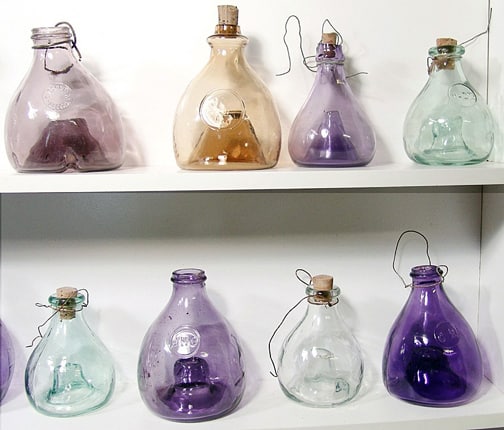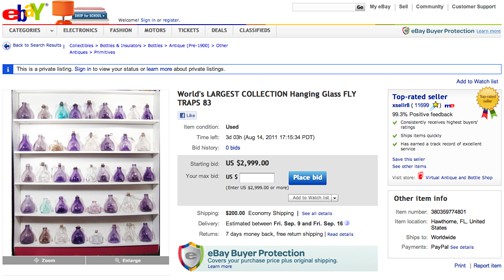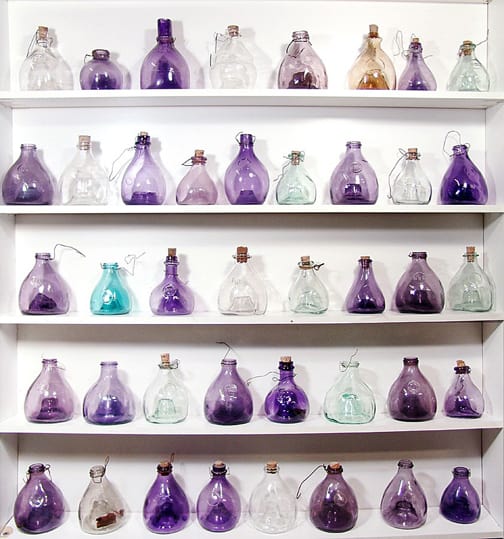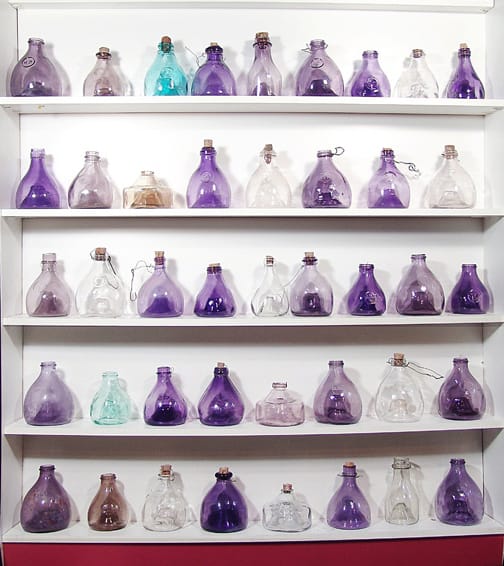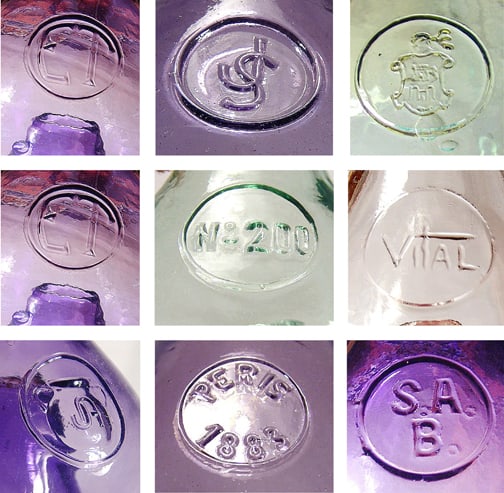Here is an unusual one on eBay today that caught my attention. I’m here in the departure lounge at BWI Airport in Baltimore waiting to catch a flight home to Houston and searching the web to kill time and I find this listing. You have to admit, this is some pretty glass with some cool embossing. This guy really photographed and wrote this up nicely.
[eBay Listing]
It is not often that you get a chance to buy a world class collection of anything, much less something as obscure and unique as hanging glass fly traps. As best I know from contact with other collectors, this is the largest single collection of hanging types in the world. A researcher in Spain has put together a database to register known embosses and forms but he has done this by copying photos on the web (many of which came from my listings) and by contributors sending in info and photos. Currently there are 14 in this collection that are not yet listed on his site.
The collection I’m offering is 83 unique traps. There are a few doubles where I have both a clear and an amethyst but for the most part either the emboss or form are noticeably different from one another. In over 15 years of antique dealing I have sold literally thousands of these traps, brought some of them back from Europe in my carry on for added protection and had the opportunity to pick through hoards of them for special ones for the collection. Unique might be a new emboss or a crude manufacturing feature or just the best mint example available. Some traps I have only run across one of and had to accept its condition as is (gladly) and some certain types all seemed to suffer from haze, but without question, this is as near a collection of mint examples as you will see. One hand blown example has a small flash and another hand worked trap has a small chip on the lip. Otherwise the only surprises are restricted to mostly small amounts of haze or manufacturing defects which are unique and often outstanding (swing etc). There are a few that will improve with a washing.
There are 23 that were blown by hand/mouth into a mold, most often a 4 piece type unique to fly traps or two piece molds and subsequently turned in the mold as was popular with bottles in the 1880’s. There are 53 in all with embossing and of these there are a few with pictorial embossings, such as my favorite, the cross. There is also a coat of arms/shield, a bean pot, a crown and interlocking initials. I have only seen one that could have been embossed with a date. It is PERIS 1883. The fellow I got it from swore it was a manufacture date but I’m more likely to believe it was an important date for that family/farm as the trap it adorns is not a hand manufactured example but an automatic bottle machine type made a few decades later.
The majority of these traps were used to combat the fruit fly in Europe at the end of the 19th and first quarter of the last century. As utilitarian items, most were blown in a clear glass. If the element used to make the batch clear was manganese it would also subsequently be responsible for the glass turning deep amethyst after expose to ultraviolet light. If selenium was used, the result was a honey amber. Though most of these amethyst/amber examples were artificially exposed to get this effect, there are a few in the group (noted in the legend) which are naturally sun colored from long expose to daylight. The aqua were blown as colored.
If these were tabletop traps of distinction, I might use the proceeds to put a child through college, but I had to sell all of those to pay the bills so the resulting collection is one that won’t break the bank to own and is guaranteed to be a conversation starter. Short of bleeding cups there aren’t many other more unique glass items from antiquity than these.
The double sided bookcase they are displayed on is included in the lot but no shipping on that (unless you pay the packers to come do it). You would have to pick it up if you want it. I will pack and ship the traps for a nominal handling charge for the time it takes. Or, you can come and pack them if you prefer. I’ve entered $200 flat rate for shipping the traps which I figure woud go in 4 boxes of 40 lbs. each. If there is excess beyond a reasonable handling amount it will be refunded, but more often I underestimate, which if that is the case I would expect the additional monies needed to facilitate shipping. I would drive up to one hour to meet with the traps and bookcase if wanted.
Please email if you have any questions or want further photos. Because of using studio lights to take the full shots of the bookcase, there were shadows created behind the traps which don’t accurately depict how they display. Also, much of the variations in form etc are too subtle to really grasp in these photos. Color is also tough to peg but I got it nailed for my LG monitor. What they come out as on yours could be from slightly to very different.
Below is a listing of all traps along with a legend below it that defines color, form, then any remaining letters are for desirable characteristics then the few condition issues. Unless otherwise noted, the embosses are inside of an embossed circle. A sampling of emboss photos are provided. More on request.
1.EFV – A – FT – PS (on trap cone, with radiations which occurred in cooling)
2.GA – A – C – H
3.No 300 – AG – B – L
4.No 200 – AG – B
5.Bean pot (pictorial) with AJ superimposed / on opposite side a cross – A – G – DE
6.JMG – A – A
7.BANDRES BONO – C – A – SB, C, T
8.CR – A – A
9.BSG – A – A – S
10.LPR – A – A – W, B, SB, PS
11.Bean pot (pictorial) with AJ superimposed / on opposite side C.E. – A – G – S, DE
12.GT – C – A
13.JCA – A – A – H
14.HR – A – A – TC
15.SOLER – A – A – TC, CT, SB
16.JS (interlocking) – A – A – SW, W
17.TORRES – A – A – W, CT
18.Pictorial coat of arms – AG – P – B, W
19.PERIS 1883 – A – A – CT
20.HDAD CORBERA – A – A – H
21.PEDRO PASQUAL – C – A – SW, SB
22.E with FV below – A – F – S, W
23.ESCARTI – C – A – S, CT
24.ESCARTI – A – A – S, B, CT
25.S.A. above a B. – A – F – W
26.S.A. above a B. – C – F – SB
27.LPR – C – A – SB
28.LL – A – A – CT
29.COOPERATIVA ALGEMISI – A – A – W
30.JMO – A – A – H
31.PAULINO HERRERO – SM – B – W, B
32.VC – A – C – S, CT
33.VC – C – C – S
34.AA – A – L – W
35.ESCARTI ALGEMISI – C – Q – W, S, CT
36.ET – A – FT – S, W
37.VITAL – C – L – W
38.F.C.R – A – Q – W
39.CR – A – A – SW
40.ARP – A – C – SW, CT
41.IO – A – C – S
42.EFM with a dot below it (letters larger than below listed EFM) – A – A – S, CT, GG
43.3 M.M.M. – A with PATENTADO below – YA – D – T
44.3 MMM PATENTADO with a pictorial crown & CN interlocking below – SA – D – B, DE, H
45.3 MMM – A PATENTADO with an empty circle below (also no periods on Ms) – C – D
46.ARJONA – A – A – SB, W, TC
47.VCS – A – A – SB, SL
48.EAG – C – FT – W
49.R. ESPANA with a dot separating from ALCIRA another dot – SM – A – SL, W
50.JGM – A – A – SB, SL, H
51.MMS – C – A – SL, CT, W
52.EFM (smaller letters, no dot) – A – A – SL, W, CT, SB, T
53.REVA – A – A – CT, SL, H
The following traps, though sometimes embossed with an empty circle, have no other embossing.
1.Empty rectangle – A – E – B, 3/4 F, H
2.C – I – AL, TM
3.Empty circle – YA – R – BIM, CT, SB, W, GT
4.A – L – TM, TC, GT
5.A – L – TM, CT (wide), B, GT
6.SA – B – W, L, H
7.Empty circle – A – R (skittle) – W, SW, H
8.Empty circle – AG – B – W, TC
9.C – B
10.Empty circle – A – A – CT, T
11.Two empty circles opposite sides – A – R – DE
12.AG – P – S, W, CB
13.Large empty oval – A – O – W, H
14.Large empty oval – AG – O – W, SB
15.Empty circle – A – B – SW, W
16.Empty circle – A – FT – SW, W, GT
17.AB – R – W, B, SW
18.A – K – B, GT
19.A – L – BIM, TM, 3/4 F, GT
20.A – A – B, L, W, SW
21.Empty oval – A – F – W, H
22.Empty circle – SA – C
23.A – N – Jagged cone edge (done in manufacture), H
24.Empty circle – A – Q – W, B, SW, GT
25.C – K – B, CT
Legend: Emboss (unless otherwise noted, all are in a circle) – Color – Body Style – Desirable Characteristics, Condition (if other than near mint).
Colors:
A = Amethyst (done by intentional exposure to artificial ultraviolet light), SA = Sun colored Amethyst (naturally colored by long exposure to the sun), SM = Smokey Amethyst (amethyst with some gray tones), C = Clear, YA = Yellow/Amber, AG = Aqua/Green, AB = Aqua/Blue
Body Types:
A = The most common large trap, B = Small trap with a roll-type lip, C = Just like B but with a more traditional lip, D = Squat, flat, stackable, E = Globe (unique), F = Blown in 4 piece mold, G = Genie bottle, I = Grooved body (unique), Q = Medium sized trap, J = Hand blown, K = Minnow trap, L = small inverted cone, N = Squat body, heavy glass and roll-type lip, O = Wide body, FT = 4 piece, tall, R = unique, P = Wide body with a thin lip
Desirable Characteristics:
W = Whittle, B = Bubbles, SW = Swirls, CT = Crude trap cone, L = lean, SL = slump, PS = Pot stone, SB = seed bubbles, S = Swing/Bridge, T = Texture, DE = double emboss, TC = tall trap cone, GG = extraneous glob of glass, AL = Applied Lip, TM = Turned in mold, BIM = Hand blown into a mold, GT = Ground top, CB = Crude base
Most traps will have at least some bubbles. I am only noting with a B, the ones that have more than average numbers. Slump refers to an area in the glass that pulled away from the mold, leaving a slumped-in depression. Whittle refers to a wavy appearance to the glass as if it were blown in a mold whittled from wood. Texture can be similar to whittle except you must be able to feel it.
Condition Issues:
H = Haze (only noted if more than 10% of the trap is affected), F = Flash (fracture which does not reach the surface)This years Downieville Bottle Show is slated for the weekend of September 10th.

